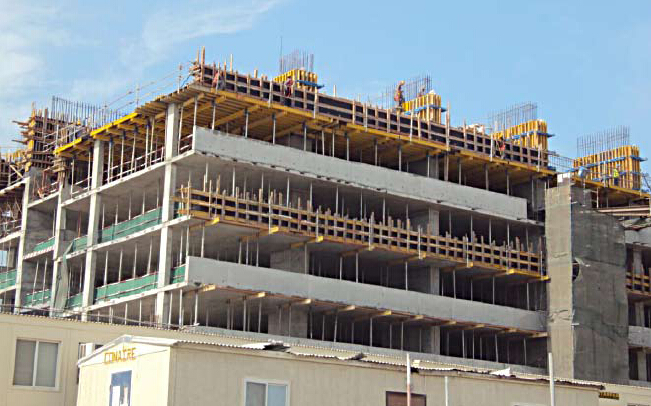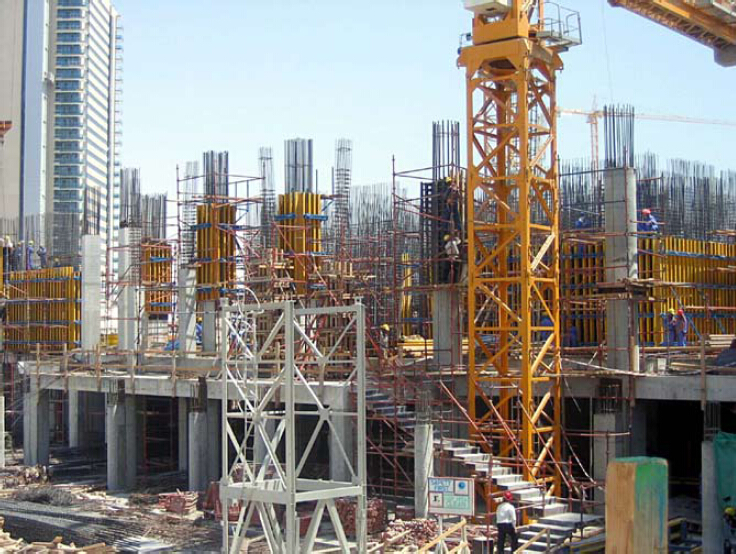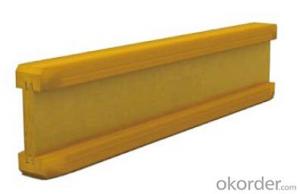Timber-Beam for Formwork and scaffolding system
- Loading Port:
- Tianjin
- Payment Terms:
- TT OR LC
- Min Order Qty:
- 50 m²
- Supply Capability:
- 1000 m²/month
OKorder Service Pledge
Quality Product, Order Online Tracking, Timely Delivery
OKorder Financial Service
Credit Rating, Credit Services, Credit Purchasing
You Might Also Like
Characteristics:
◆ Standardized production lines.
Supply capability: 3000m/day, Lmax = 6600mm.
◆ Finger jointing of the flange and web, the strength of timber beam is highly improved.
Max. shearing force failure load:40KN
◆ Well treated to prevent from water penetration or erosion, so the service life maximally extended.
Normally, CNBM timber beam H20 can be used for 4 to 5 years, the exact using time would depend on maintenance & storage.
◆ Robust caps at the end of the girders protect against damages.


- Q:Can steel formwork be used for complex geometric designs?
- Yes, steel formwork can be used for complex geometric designs. Steel is a versatile material that can be easily shaped and molded into various intricate forms, making it suitable for complex geometric designs. Steel formwork allows for precise and accurate construction, ensuring that the desired shape and dimensions of the design are achieved. Additionally, the strength and durability of steel make it suitable for supporting the weight and pressure exerted during the concrete pouring process. This makes steel formwork a reliable choice for creating complex geometric designs in construction projects.
- Q:How does steel formwork impact the overall project budgeting?
- The overall project budgeting can be significantly affected by steel formwork. Although the initial cost of steel formwork may be higher compared to wood or plastic formwork, it offers several advantages that can help offset the initial investment. To begin with, steel formwork is renowned for its durability and longevity. Unlike wood or plastic formwork, steel formwork can be reused multiple times without compromising its structural integrity. This reusability factor reduces the need for frequent replacement or repair, resulting in long-term cost savings. Furthermore, steel formwork provides a superior finish to concrete structures. The smooth and even finish achieved with steel formwork minimizes the need for additional surface treatments or finishing work, leading to cost savings. Moreover, steel formwork offers increased strength and stability, enabling the construction of larger and more complex structures. This eliminates the necessity for additional support systems or reinforcements, which can be costly and time-consuming. Additionally, steel formwork is easy to assemble and dismantle, resulting in faster construction times. The quick turnaround time reduces labor costs and allows for earlier project completion, which is particularly advantageous for time-sensitive projects. Lastly, steel formwork is resistant to adverse weather conditions, such as moisture or extreme temperatures, which can negatively impact the effectiveness and lifespan of the formwork. This resistance reduces the risk of formwork damage and replacement costs, contributing to cost savings. In conclusion, while steel formwork may have a higher upfront cost, its durability, reusability, high-quality finish, strength, ease of use, and resistance to weather conditions can all contribute to cost savings in terms of reduced labor, material, and maintenance expenses. Therefore, steel formwork can positively impact the overall project budgeting.
- Q:Are there any disadvantages to using steel formwork?
- Using steel formwork does have its drawbacks. One major disadvantage is the steep initial cost associated with it. Compared to other formwork options like wood or plastic, steel formwork is pricier to purchase or rent. This can pose a significant challenge for smaller construction projects or contractors operating on a tight budget. Another drawback lies in the weight of steel formwork. It is considerably heavier than alternative materials, making it more difficult to handle and transport. This can result in increased labor costs and a greater need for manpower when setting up or dismantling the formwork. Moreover, assembling and dismantling steel formwork requires skilled labor. It is crucial to have experienced workers who possess the knowledge of correct procedures and techniques to ensure the safety and stability of the formwork. This, in turn, can contribute to higher project costs and extended timelines. Steel formwork is also susceptible to corrosion if not properly maintained. Exposure to moisture and chemicals can lead to rust and deterioration, compromising the formwork's integrity and posing safety risks. Regular inspections and maintenance are necessary to prevent and address corrosion issues. Lastly, steel formwork lacks the flexibility and adjustability found in other types of formwork. Once it is fabricated, it becomes difficult to modify or adjust to accommodate changes in design or dimensions. This inflexibility can be a disadvantage in projects where modifications or adjustments are frequently required. In conclusion, while steel formwork does offer advantages such as durability and reusability, it is important to consider its disadvantages when selecting the appropriate formwork for a construction project.
- Q:What are the different types of ties used in steel formwork construction?
- Steel formwork construction utilizes various types of ties to hold the formwork panels together and ensure the stability and integrity of the structure. Some commonly used ties in this construction method include: 1. Snap ties are the most frequently employed ties in steel formwork construction. They consist of a metal rod and a flat plate. The rod is inserted through holes in the formwork panels, and the plate is attached to secure the panels. Snap ties are quick and easy to install and can be easily removed after the concrete cures. 2. Tie rods are long steel rods with threading on both ends. They are used to connect the formwork panels by passing them through the panel holes and securing them with nuts and washers. Tie rods provide robust and stable connections that can withstand high pressure and loads. 3. She-bolts are similar to tie rods but have a fixed female thread at one end. Used in combination with wing nuts and washers, she-bolts hold the formwork panels together. They are particularly useful when tie rods need to be quickly and easily removed. 4. Flat ties are flat-shaped steel wires or bars. They are inserted through the formwork panel holes and secured with cones or washers. Flat ties establish a secure connection between the panels and are commonly used in large-scale construction projects. 5. Coil ties are flexible steel wires coiled at one end and threaded at the other. They are inserted through the formwork panel holes and secured with cones or washers. Coil ties are especially advantageous in curved or irregular-shaped structures. 6. Combination ties merge the characteristics of snap ties and tie rods. They consist of a metal rod with a flat plate at one end and a threaded end at the other. Combination ties are versatile and can be utilized in diverse formwork applications. Choosing the appropriate tie type is crucial for steel formwork construction projects. Factors such as the structure's size and shape, required load-bearing capacity, and ease of installation and removal influence the tie selection.
- Q:Can steel formwork be used for projects with stringent quality requirements?
- Yes, steel formwork can definitely be used for projects with stringent quality requirements. Steel formwork is known for its durability, strength, and consistency, making it an ideal choice for projects where precision, accuracy, and high-quality finishes are essential. Steel formwork is capable of withstanding heavy loads and can maintain its shape and dimensions over multiple uses, ensuring that the concrete structure is formed accurately and precisely according to the design specifications. Additionally, steel formwork provides a smooth surface finish, reducing the need for extensive post-construction finishing work. Its robustness and stability make it suitable for projects requiring stringent quality control, such as high-rise buildings, bridges, and infrastructure projects. Furthermore, steel formwork allows for easy customization, enabling contractors to meet specific project requirements efficiently. Overall, steel formwork is a reliable and efficient choice for projects with stringent quality requirements, ensuring that the final structure meets the highest standards of quality and durability.
- Q:Can steel formwork be used for both reinforced and unreinforced concrete structures?
- Yes, steel formwork can be used for both reinforced and unreinforced concrete structures. Steel formwork provides excellent strength and durability, making it suitable for supporting the weight and pressure of both reinforced and unreinforced concrete during the casting and curing process.
- Q:Can steel formwork be customized for different project requirements?
- Yes, different project requirements can be met through customizing steel formwork. Steel formwork is renowned for its adaptability and versatility, making it suitable for a wide range of construction projects. It can be easily modified and adjusted to accommodate various dimensions, shapes, and designs. The customization of steel formwork involves altering its size, shape, and configuration to fit specific project needs. This can be achieved by cutting, welding, and bending the steel sheets or frames according to desired specifications. Steel formwork can be conveniently adjusted on-site or in a workshop, allowing for swift modifications and adaptations when necessary. Moreover, the utilization of steel formwork enables the creation of intricate and complex structures. It can be effortlessly molded and shaped to meet unique project demands, including curved or irregular surfaces. Additionally, steel formwork can be combined with other materials like plywood or timber to enhance its versatility and further tailor it to specific project requirements. In conclusion, the inherent flexibility and adaptability of steel formwork make it possible to customize it for diverse project requirements. Its capability to be modified and adjusted enables the construction of a variety of structures, making it a favored choice in the construction industry.
- Q:Can steel formwork be used for architectural concrete slabs?
- Yes, steel formwork can be used for architectural concrete slabs. Steel formwork offers several advantages in terms of strength, durability, and versatility compared to other types of formwork materials. It provides a rigid structure that can withstand the pressure of fresh concrete, ensuring accurate and precise placement of the slabs. Additionally, steel formwork can be easily reused multiple times, making it cost-effective and environmentally friendly. Its smooth surface also results in a high-quality finish for architectural concrete slabs. However, it is essential to ensure proper insulation and release agents are used to prevent the steel from transferring heat or causing concrete adherence issues. Overall, steel formwork is a reliable and efficient choice for creating architectural concrete slabs.
- Q:How does steel formwork affect the overall project budget and cost control?
- Steel formwork has the potential to significantly impact the overall project budget and cost control. To start with, steel formwork offers a durable and reusable alternative to traditional timber formwork. Although the initial investment in steel formwork may be higher, it can be utilized for multiple projects, resulting in long-term cost savings. Moreover, steel formwork provides greater accuracy and precision, leading to reduced material wastage and labor costs. The precise dimensions and alignment offered by steel formwork contribute to improved quality and faster construction, thereby reducing the overall project duration and associated expenses. Additionally, steel formwork is renowned for its strength and stability, enabling higher concrete pouring rates and larger pour sizes. This enhances productivity and reduces the necessary labor, positively impacting the project budget. Furthermore, steel formwork necessitates less maintenance and repairs, thus decreasing ongoing expenses. Unlike timber formwork, steel formwork is not susceptible to rot, warping, or damage caused by insects, weather, or repetitive use. The longevity and durability of steel formwork help minimize replacement and repair costs. However, it is crucial to consider that the installation and removal of steel formwork may require specialized skills and equipment. This can affect labor costs and may necessitate additional training or the hiring of experienced workers, which should be taken into account when planning the project budget. In conclusion, the utilization of steel formwork can have a positive impact on the overall project budget and cost control due to its durability, reusability, accuracy, efficiency, and reduced maintenance requirements. Although the initial investment may be higher, the long-term benefits, such as reduced material wastage, improved quality, increased productivity, and decreased repair costs, make steel formwork a cost-effective choice for construction projects.
- Q:What is the maximum load that steel formwork can support?
- The maximum load that steel formwork can support depends on various factors such as the thickness and quality of the steel, the structural design and configuration of the formwork, and the supporting structure it is attached to. Generally, steel formwork is designed to withstand heavy loads and is commonly used for high-rise construction projects. However, it is essential to consult the manufacturer's specifications and engineering calculations to determine the specific maximum load capacity for a particular steel formwork system. Additionally, the maximum load capacity can also be influenced by the type of concrete being poured, the duration of the load, and any dynamic forces that may be present during construction. To ensure safety and structural integrity, it is recommended to engage a qualified engineer or structural designer who can assess the specific requirements of the construction project and provide accurate load capacity information for the steel formwork being used.
1. Manufacturer Overview |
|
|---|---|
| Location | |
| Year Established | |
| Annual Output Value | |
| Main Markets | |
| Company Certifications | |
2. Manufacturer Certificates |
|
|---|---|
| a) Certification Name | |
| Range | |
| Reference | |
| Validity Period | |
3. Manufacturer Capability |
|
|---|---|
| a)Trade Capacity | |
| Nearest Port | |
| Export Percentage | |
| No.of Employees in Trade Department | |
| Language Spoken: | |
| b)Factory Information | |
| Factory Size: | |
| No. of Production Lines | |
| Contract Manufacturing | |
| Product Price Range | |
Send your message to us
Timber-Beam for Formwork and scaffolding system
- Loading Port:
- Tianjin
- Payment Terms:
- TT OR LC
- Min Order Qty:
- 50 m²
- Supply Capability:
- 1000 m²/month
OKorder Service Pledge
Quality Product, Order Online Tracking, Timely Delivery
OKorder Financial Service
Credit Rating, Credit Services, Credit Purchasing
Similar products
New products
Hot products
Hot Searches
Related keywords
























